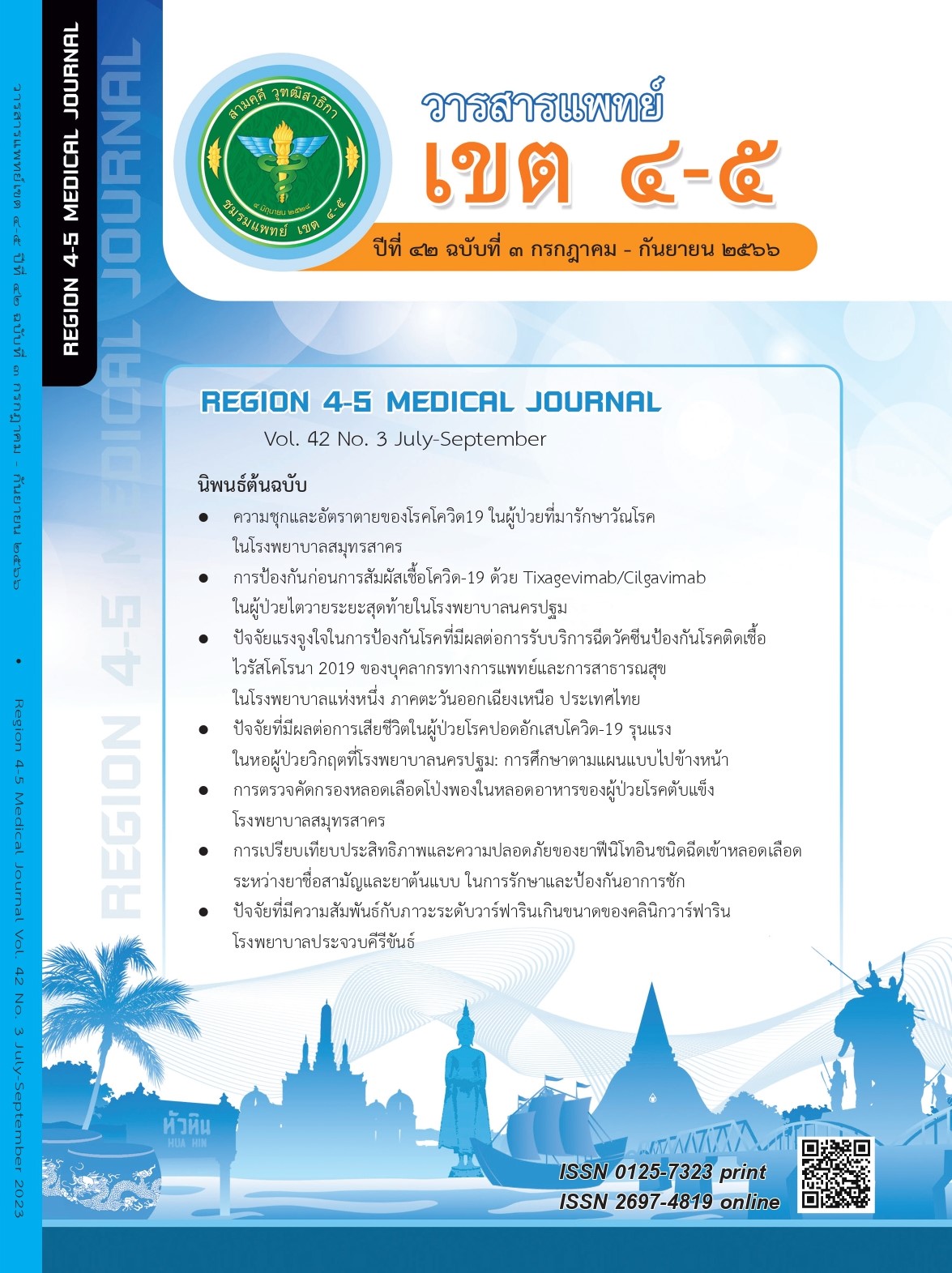การตรวจคัดกรองโรคมะเร็งลำไส้ใหญ่/ไส้ตรง ด้วยวิธีตรวจหาเลือดแฝงในอุจจาระ โรงพยาบาลสมุทรสาคร
คำสำคัญ:
โรคมะเร็งลำไส้ใหญ่/ไส้ตรง, วิธีตรวจหาเลือดแฝงในอุจจาระบทคัดย่อ
วัตถุประสงค์: เพื่อศึกษาความชุกและปัจจัยเสี่ยงของโรคมะเร็งลำไส้ใหญ่/ไส้ตรงของประชากรอายุตั้งแต่ 50–75 ปีขึ้นไป
วิธีการศึกษา: เป็นการศึกษาแบบ prospective study ทำการเก็บข้อมูลจากแบบคัดกรองโรคมะเร็งลำไส้ใหญ่/ไส้ตรง ในคลินิกทางเดินอาหาร ตั้งแต่ 1 ตุลาคม พ.ศ. 2565 ถึง 31 มีนาคม พ.ศ. 2566 และผลการส่องกล้องทางเดินอาหารส่วนล่าง โดยทำการวิเคราะห์ข้อมูลโดยใช้ค่า mean, median, SD, range, 95% CI, และ odds ratio
ผลการศึกษา: ผู้ที่มาตรวจคัดกรองพบว่า อายุเฉลี่ย 61 ± 6 ปี เป็นเพศหญิง 42 คน (ร้อยละ 60.9) นอกจากนี้ มีโรคประจำตัวร่วมมากที่สุด คือความดันโลหิตสูง จำนวน 32 คน (ร้อยละ 46.4) รองลงมา คือเบาหวาน จำนวน 20 คน (ร้อยละ 29)
ผลการส่องกล้องทางเดินอาหารส่วนล่าง พบว่า ผลปกติ จำนวน 25 คน (ร้อยละ 36.2) พบมีติ่งเนื้องอก จำนวน 27 คน (ร้อยละ 39.1) และพบเป็นมะเร็ง จำนวน 5 คน (ร้อยละ 7.2) โดยชนิดของติ่งเนื้อ เป็น hyperplastic polyp มากที่สุด จำนวน 13 คน (ร้อยละ 18.8) และตำแหน่งที่พบติ่งเนื้อมากที่สุด คือ sigmoid colon จำนวน 13 คน (ร้อยละ 18.8) รองลงมา คือ hepatic flexure จำนวน 6 คน (ร้อยละ 8.7)
สรุป: โรงพยาบาลสมุทรสาคร พบความชุกโรคมะเร็งลำไส้ใหญ่/ไส้ตรง เท่ากับร้อยละ 7.2 จากการตรวจคัดกรองโรคมะเร็งลำไส้ใหญ่/ไส้ตรง ด้วยวิธีตรวจหาเลือดแฝงในอุจจาระ และพฤติกรรมชอบรับประทานผัก/ผลไม้ พบความเสี่ยงในการเกิดโรคมะเร็งลำไส้ใหญ่/ไส้ตรงในผู้ที่มาตรวจคัดกรองน้อยกว่าอย่างมีนัยยะสำคัญทางสถิติ (p-value < .05)
เอกสารอ้างอิง
Bhandari A, Woodhouse M, Gupta S. Colorectal cancer is a leading cause of cancer incidence and mortality among adults younger than 50 years in the USA: a SEER-based analysis with comparison to other young-onset cancers. J Investig Med 2017;65 (2):311–15. doi: 10.1136/jim-2016-000229.
Bray F, Ferlay J, Soerjomataram I, et al. Global cancer statistics 2018: GLOBOCAN estimates of incidence and mortality worldwide for 36 cancers in 185 countries. CA Cancer J Clin 2018;68(6):394–424. doi: 10.3322/caac.21492.
Siegel RL, Miller KD, Sauer AG, et al. Colorectal cancer statistics, 2020. CA Cancer J Clin 2020;70(3):145–64. doi: 10.3322/caac.21601.
Montminy EM, Zhou M, Maniscalco L, et al. Contributions of adenocarcinoma and carcinoid tumors to early-onset colorectal cancer incidence rates in the United States. Ann Intern Med 2021;174(2):157–66. doi: 10.7326/M20-0068.
NCI's Division of Cancer Control and Population Sciences (DCCPS). SEER stat database incidence Volume 2021 [internet]. 2021 [cited 2021 February 14]; Available from: URL: http://seer.cancer.gov/seerstat/.
Lin JS, Perdue LA, Henrikson NB, et al. Screening for colorectal cancer: updated evidence report and systematic review for the US Preventive Services Task Force. JAMA 2021;325(19):1978–97. doi:10.1001/jama.2021.4417.
Bailey CE, Hu CY, You YN, et al. Increasing disparities in the age-related incidences of colon and rectal cancers in the United States, 1975–2010. JAMA Surg 2015;150(1):17–22. doi: 10.1001/jamasurg.2014.1756.
Morson BC. Evolution of cancer of the colon and rectum. Cancer 1974;34(3):845–9. doi: 10.1002/1097-0142(197409)34:3+<845::aid-cncr2820340710>3.0.co;2-h.
Barré S, Leleu H, Benamouzig R, et al. Cost-effectiveness analysis of alternative colon cancer screening strategies in the context of the French national screening program. Therap Adv Gastroenterol 2020;13. doi: 10.1177/1756284820953364.
Khuhaprema T, Sangrajrang S, Lalitwongsa S, et al. Organised colorectal cancer screening in Lampang Province, Thailand: preliminary results from a pilot implementation programme. BMJ Open 2014;4(1):e003671. doi: 10.1136/bmjopen-2013-003671.
Sittipong T, Surawut C. Cororectal cancer screening by fecal immunochemical testing with colonocscopy in Chonburi Province. Chonburi Hospital Journal 2019;44(2):89–95.
Mangas-Sanjuan C, Zapater P, Cubiella J, et al. Importance of endoscopist quality metrics for findings at surveillance colonoscopy: The detection-surveillance paradox. United European Gastroenterol J 2018;6(4):622–9. doi: 10.1177/2050640617745458.
Wang H, Wang P, Liu X, et al. Factors predicting the colorectal adenoma detection rate in colonoscopic screening of a Chinese population: A prospective study. Medicine (Baltimore) 2019;98(15):e15103. doi: 10.1097/MD.0000000000015103.
Kastenberg D, Bertiger G, Brogadir S. Bowel preparation quality scales for colonoscopy. World J Gastroenterol 2018;24(26):2833–43. doi: 10.3748/wjg.v24.i26.2833.
Calderwood AH, Jacobson B. Comprehensive validation of the Boston Bowel Preparation Scale. Gastrointest Endosc 2010;72(4):686–92. doi: 10.1016/j.gie.2010.06.068.
Alvarez-Gonzalez MA, Pantaleon MA, Flores-Le Roux JA, et al. Randomized clinical trial: A normocaloric low-fiber diet the day before colonoscopy is the most effective approach to bowel preparation in colorectal cancer screening colonoscopy. Dis Colon Rectum 2019;62(4):491–7. doi: 10.1097/DCR.0000000000001305.
Jiao L, Wang J, Zhao W, et al. Comparison of the effect of 1-day and 2-day low residue diets on the quality of bowel preparation before colonoscopy. Saudi J Gastroenterol 2020;26(3):137–43. doi: 10.4103/sjg.SJG_471_19.
Subramanian V, Ragunath K. Advanced endoscopic imaging: A review of commercially available technologies. Clin Gastroenterol Hepatol 2014;12(3):368–76. doi: 10.1016/j.cgh.2013.06.015.
Soeder M, Turshudzhyan A, Rosenberg L, et al. High- Quality Colonoscopy: A review of Quality indicators and Best Practices. Gastroenterol Insights 2022;13(2):162–72. doi.org/10.3390/gastroent13020017.
ดาวน์โหลด
เผยแพร่แล้ว
รูปแบบการอ้างอิง
ฉบับ
ประเภทบทความ
สัญญาอนุญาต

อนุญาตภายใต้เงื่อนไข Creative Commons Attribution-NonCommercial-NoDerivatives 4.0 International License.
ลิขสิทธิ์บทความเป็นของผู้เขียนบทความ แต่หากผลงานของท่านได้รับการพิจารณาตีพิมพ์ลงวารสารแพทย์เขต 4-5 จะคงไว้ซึ่งสิทธิ์ในการตีพิมพ์ครั้งแรกด้วยเหตุที่บทความจะปรากฎในวารสารที่เข้าถึงได้ จึงอนุญาตให้นำบทความในวารสารไปใช้ประโยชน์ได้ในเชิงวิชาการโดยจำเป็นต้องมีการอ้างอิงถึงชื่อวารสารอย่างถูกต้อง แต่ไม่อนุญาตให้นำไปใช้ในเชิงพาณิชย์




